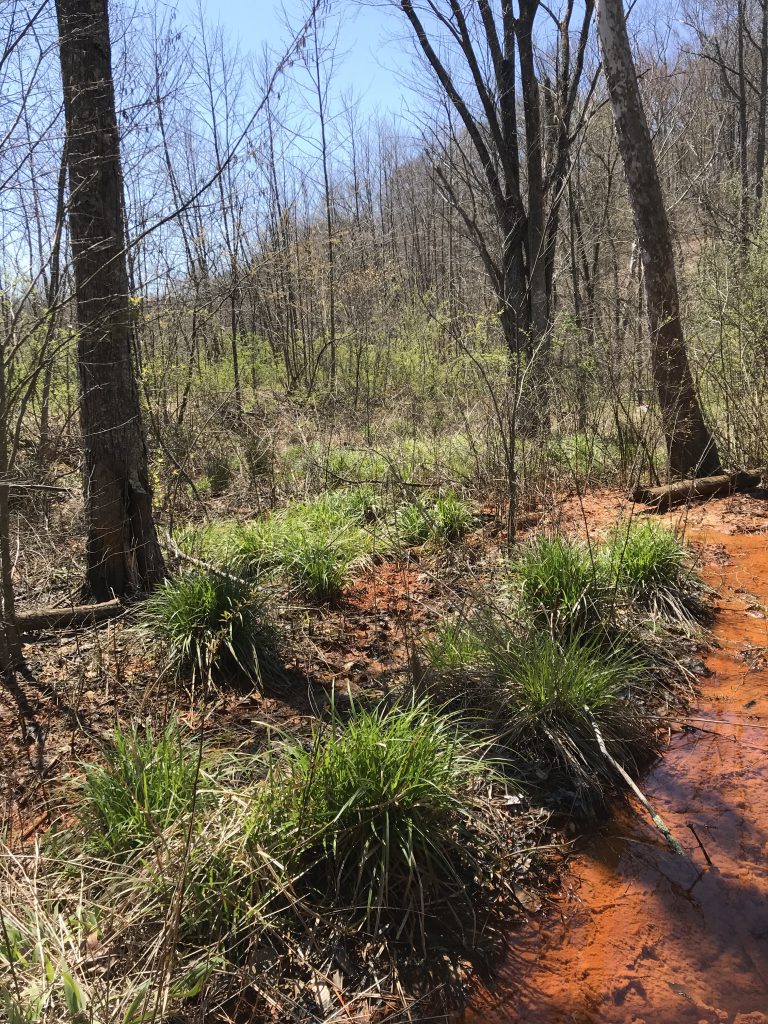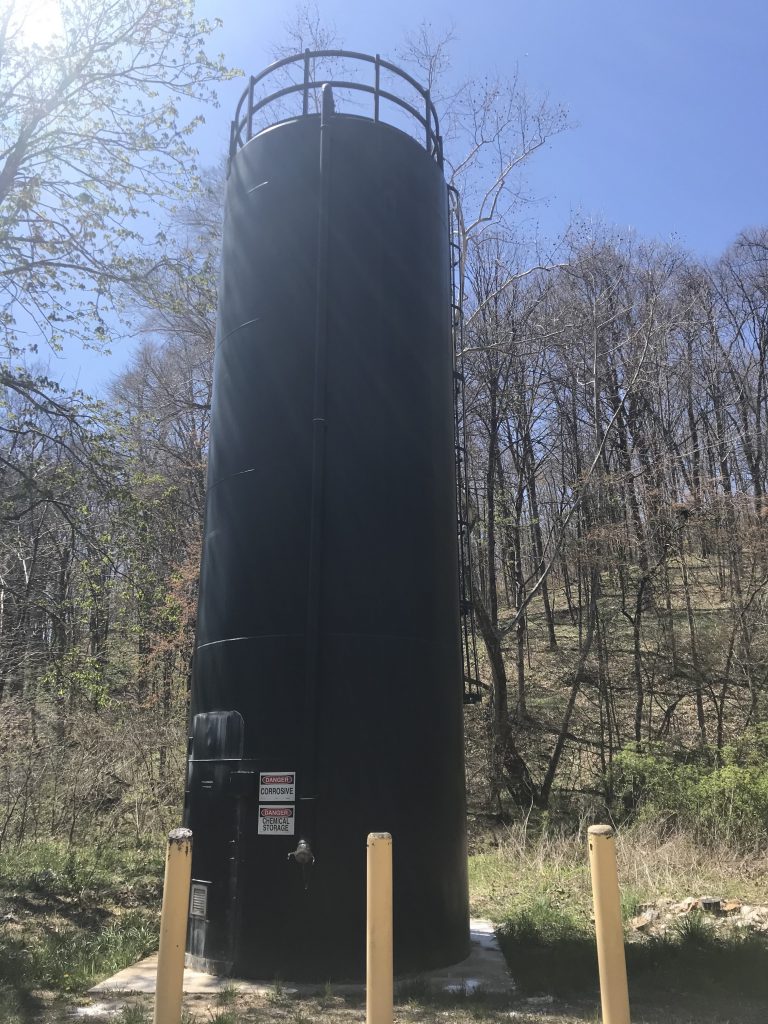This week, you learned about pH and how coal mining has acidified local streams. A lot of wildlife cannot live in or around streams with acid mine drainage. Luckily, we can do a lot to help streams recover! What ideas do you have for how to make these creeks healthy again?
In this lesson, we’ll cover:
If you need a review of what acid mine drainage is, watch these short videos of Pine Run (Perry County, Ohio).
The easiest and best way for us to fix AMD is to not let it happen in the first place. We can’t undo the mining that already happened. So how can we stop AMD from happening?
Stopping AMD before it’s made
Do you remember the three things that make AMD?
- iron pyrite (in the coal)
- water
- air.
If we stop these things from mixing
, then no AMD will form. This is called Source Control.The best way to stop AMD from forming? Keep water from touching and mixing with the pyrite.
Sometimes this means covering big piles of leftover coal waste, also known as gob piles, with impermeable soil. Impermeable means no liquid can pass through. The impermeable soil stops water from reaching any iron pyrite in the first place.
Another way we prevent water from mixing with iron pyrite is preventing stream capture. How and why do you think we could capture a stream?
Sometimes, above old mines, the ground collapses. It falls into the empty space where the coal had been removed. This is a sinkhole. If there is a stream above it, the stream flows down through the sinkhole into the old coal mine (Ahhhh! exactly the opposite of what we want to happen!). Now the stream is “captured” by the mine. Eventually, water fills up the mine and spills out into nearby streams with acid mine drainage.
To prevent this, we fill the collapsing sinkhole with impermeable soil. Then we change the stream’s path to go around it. Now the stream water never mixes with old mines, and never makes AMD!
Treating AMD
Sometimes, we just cannot prevent AMD from forming. I think of it as the stream getting sick. We try our hardest to prevent the stream from getting sick (AMD) but sometimes it happens. So we have to give it ‘medicine’ to treat it.
There are two different ways we do this: passive treatment and active treatment. To remember the differences of these two words, I think of my lazy or “passive” kitty taking a nap and then my other crazy “active” kitty chasing his toys around the house!
When we passively treat AMD, we build something that treats the water, then leave it be! Once it is built, it doesn’t need much maintenance or work. One example is a wetland.
Passive Treatment: Wetlands

Wetlands are amazing ecosystems. As well as helping treat AMD, they provide habitat for native birds and other wildlife. They also hold water during floods. Wetlands can help treat AMD by making water slowwww downnnn.
When the water slows down, oxygen and tiny bacteria have more time to work their magic. The iron forms here instead of downstream, creating this gunky orange wetland! So how does this help our fish? Well, by controlling where our iron forms (orange gunk), we keep it from washing into rest of the stream, where it will affect all the critters living there.
But iron is only half of the problem. Our pH is still too low. This water is still acidic. To fix this, we must add something with a high pH to raise the pH of the water to a healthy level.
A passive way to do this is to add limestone gravel, just like the kind in your driveway! We reroute our stream, making it flow through layers of limestone. Some of the limestone will dissolve just like sugar in water, raising the pH of the water to a healthy, neutral level.
Neither the wetland nor the limestone gravel need maintenance every year. They can be left alone for long periods of time and still work. This is a cheaper and easier solution in the long run, if you have enough space for a wetland.
Active treatment: Lime dosers
Finally, our last resort for treating AMD is called a “doser,” which is a form of active treatment. Active treatment means people have to keep taking care of the doser, or it won’t work.

Dosers are tall silos, full of activated, powdered lime (it’s made from limestone, not the fruit!!). This lime has a very high pH (it’s basic). The silo pours little doses of basic lime into the acidic water, raising the pH.
We have to refill the dosers with more powdered lime often. If the doser runs out of lime, the treatment immediately stops working and the stream returns to being too acidic almost immediately. So these dosers require a lot of attention!
Downstream of these dosers, fish have come back to creeks that had been empty for years.
There’s no one right choice
To sum up, there are a ton of different things that water quality specialists and environmentalists must think about before we can treat AMD. No two Acid Mine Discharge sites are the same. In many places, we use a variety of the techniques from above to fix the streams as best we can. Here is a handy little chart to help you compare:

Activity: “Dose” your own AMD
In Monday’s lesson, we learned how to test the pH of a liquid.
Today, we’ll explore how to change the pH of a liquid. That’s what we do when we treat acid mine drainage. Watch what happens when an ultra-basic material (our lime powder, which has a pH of 14+) meets an acidic material (acid mine drainage):
Woah! The basic lime and acidic mine drainage react. This reaction releases energy as heat. Did you see steam from the reaction and the cup melting? It is very hot!
This happens when we add a little bit of AMD to a LOT of powdered lime. This causes the reaction to happen very fast, so we can see it. The doser adds only a little lime to a lot of water and AMD. So the reaction happens much more slowly in the stream, and is not so dangerous.
We can create a similar reaction at home mixing two common items: vinegar (acidic, or low pH) and baking soda (basic, or high pH).
Materials needed:
- Vinegar
- Baking soda
- Measuring spoons
- Large bowl
- Notebook/pencil
- Your thinking cap!
To create the reaction:
- Measure out ½ cup of vinegar into a large bowl.
- Add a tablespoon of baking soda to the vinegar. Observe what happens. What is similar or different from my video above?
- Imagine your vinegar is a stream we are trying to fix. Could you make the vinegar neutral? How?
- Continue to experiment slowly with adding more or less baking soda. If the reaction stops, the pH is probably close to neutral.
Congrats–you just changed the pH!
To be sure whether it worked, you can check the pH of your treated vinegar with the cabbage indicator or pH strips.
Summary
- We treat acid mine drainage either by stopping it from forming, or by fixing the pH.
- To fix the pH, we can use passive treatments (wetlands) or active treatments (lime dosers).
- Try changing pH yourself at home with the baking soda and vinegar experiment. You are doing the same basic thing we do to make our creek liveable for fish!